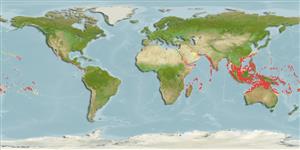Environment: milieu / climate zone / depth range / distribution range
Ecología
marino asociado a arrecife; rango de profundidad 0 - 100 m (Ref. 89972). Tropical; 30°N - 24°S
Indo-Pacific: Persian Gulf (Ref.80050); Red Sea and East Africa to the central Indian Ocean and French Polynesia. Eastern Pacific: Mexico and Panama. The exact range is uncertain because of confusion with Sphyraena jello and Sphyraena putnamae (Ref. 9768).
Tamaño / Peso / Age
Maturity: Lm ? range ? - ? cm
Max length : 170 cm TL macho / no sexado; (Ref. 9710); common length : 80.0 cm TL macho / no sexado; (Ref. 9768); peso máximo publicado: 7.1 kg (Ref. 40637)
Espinas dorsales (total): 6; Radios blandos dorsales (total): 9; Espinas anales 2; Radios blandos anales: 7 - 9. Many dark bars crossing lateral line on body, each bar oblique in upper half, but nearly vertical in the lower; caudal fin largely blackish. No gill rakers on first arch; upper and lower gill arch with rough platelets, each platelet not bearing distinct spine.
Found near current-swept lagoon and seaward reefs (Ref. 9710). Feeds on fishes (Ref. 89972). Usually seen in large semi-stationary schools during the day (Ref. 9768) which have a tendency to occupy the same site for months or even years at a time. Probably disperses at night to feed (Ref. 1602). Often hooked by trolling between dusk and dawn (Ref. 37816). Minimum depth reported taken from Ref. 128797.
Life cycle and mating behavior
Madurez | Reproducción | Puesta | Huevos | Fecundidad | Larva
In general, barracudas in large numbers aggegate during spawning season and migrate to specific spawning areas (Ref. 240).
De Sylva, D.P. and F. Williams, 1986. Sphyraenidae. p. 721-726. In M.M. Smith and P.C. Heemstra (eds.) Smiths' sea fishes. Springer-Verlag, Berlin. (Ref. 5491)
IUCN Red List Status (Ref. 130435)
Threat to humans
Reports of ciguatera poisoning (Ref. 4537)
Human uses
Pesquerías: comercial; pesca deportiva: si
Más información
ReferenciasAcuiculturaPerfil de acuiculturaRazasGenéticaElectrophoresesheritabilidadEnfermedadesProcesamientoNutrientsMass conversion
ColaboradoresImágenesStamps, Coins Misc.SonidosCiguateraVelocidadTipo de nataciónSuperficie branquialOtolitosCerebrosVisión
Herramientas
Special reports
Download XML
Fuentes de Internet
Estimates based on models
Preferred temperature (Ref.
123201): 26.1 - 29, mean 28.1 °C (based on 1626 cells).
Phylogenetic diversity index (Ref.
82804): PD
50 = 0.5000 [Uniqueness, from 0.5 = low to 2.0 = high].
Bayesian length-weight: a=0.00724 (0.00339 - 0.01546), b=2.92 (2.74 - 3.10), in cm total length, based on LWR estimates for this Genus-body shape (Ref.
93245).
Nivel trófico (Ref.
69278): 4.5 ±0.80 se; based on food items.
Resiliencia (Ref.
120179): Muy bajo, población duplicada en un tiempo mínimo superior a 14 años (Preliminary K or Fecundity.).
Fishing Vulnerability (Ref.
59153): Very high vulnerability (90 of 100).
Nutrients (Ref.
124155): Calcium = 9.8 [4.8, 25.1] mg/100g; Iron = 0.241 [0.113, 0.501] mg/100g; Protein = 20.2 [18.2, 21.9] %; Omega3 = 0.0769 [, ] g/100g; Selenium = 47 [19, 118] μg/100g; VitaminA = 33 [7, 160] μg/100g; Zinc = 0.4 [0.3, 0.7] mg/100g (wet weight);
